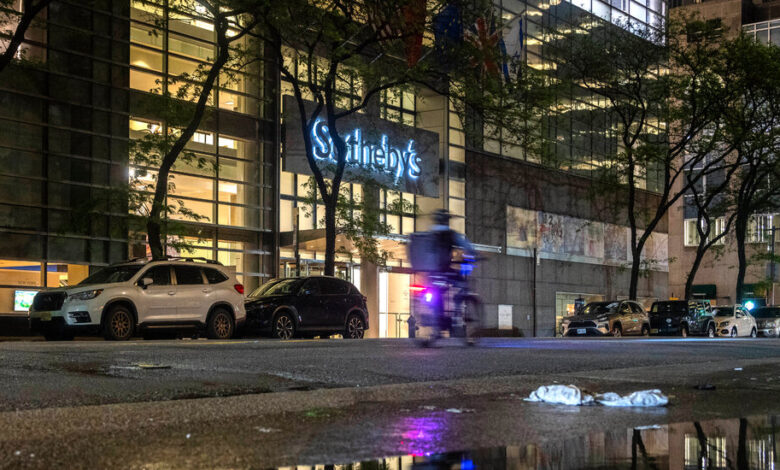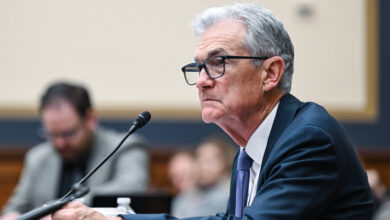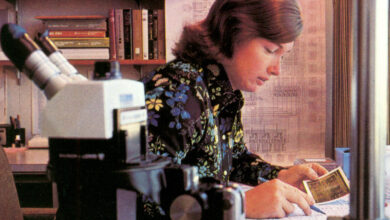The Night That Sotheby’s Was Crypto-Punked

It would have been the greatest insult to rock the Upper East Side on any normal night, but instead the private equity heir Holly Peterson could only laugh. Why had a Sotheby’s official denied her access to a bidding paddle?
In February 2022, Ms. Peterson, an author and art collector, was surrounded by a new clientele: the crypto nouveau riche, who made a temporary home of the art market. Their purchases occurred through the trendy innovation of NFTs, or nonfungible tokens, which registered the ownership of often digital artworks on the blockchain. Collectors then used the NFTs as rapidly appreciating investments to build their crypto fortunes.
The young collectors arrived in sweatpants and greeted one another by their Twitter handles. It was supposed to be another banner evening for the booming art market, where NFTs had come to represent almost half of the industry’s $65 billion valuation in only a couple of years. The marquee lot included 104 CryptoPunks, a selection of algorithmically generated portraits of pixelated people that epitomized the rise of blockchain-based collectibles. They were estimated to sell for $20 million to $30 million, and, for the first time, Sotheby’s had devoted a major sale to just a single lot of NFTs. It was a rare honor — one that hadn’t even occurred when the auction houses had a $450 million Leonardo da Vinci on their hands.
The night received all the marketing gusto that a company serving billionaires and their baubles could muster. Sotheby’s had described the event, called “Punk It!”, as “on par with the most significant and high-profile sales for contemporary and modern art.”
But there were early signs that the NFT market was crashing — a spectacular implosion that would shine a spotlight on the government’s failure to regulate the art market.
Ms. Peterson was one of many traditional collectors who attended the auction to purchase their first NFT. Her father was Peter G. Peterson, the private equity billionaire who founded Blackstone and served as a Museum of Modern Art trustee. And she was a trustee at the Studio Museum in Harlem and on several acquisition committees for organizations like the Whitney Museum of American Art, the Brooklyn Museum and Centre Pompidou.
But none of that pedigree could prepare her for the bizarre scene at Sotheby’s.
Ms. Peterson looked around and saw these new collectors who reminded her of little toddlers with paddles, she recalled in an interview. “What’s going on?” she said. “I’m a Park Avenue woman with a fancy art collection and I couldn’t even get a paddle.”
Buyers could pay in cryptocurrencies or regular dollars. A panel that preceded the sale included Kenny Schachter, a rabble-rousing collector and columnist at Artnet News, who, from his brownstone on the Upper East Side, had situated himself as a communicator between the crypto and traditional art worlds. (He had his own NFT project to promote.) A bulldog for the digital art movement, he managed to corner Max Hollein, the Met Museum director, one evening in Central Park, recalling that the museum executive said that his curators were too scared of the new technology to partake.
Speaking to the V.I.P. attendees at the Sotheby’s auction, Mr. Schachter waxed poetic about the promises of NFTs, saying they had “changed the history of art without even intending to be an art piece in the first place.”
An audience that included celebrity influencers like the rapper Ja Rule and Snoop Dogg’s son Cordell Broadus clapped. Behind the scenes, employees were scrambling to salvage what was supposed to be a historic sale.
According to three people close to the sale, there had been signs of trouble from the beginning of the auction house’s relationship with the seller, who operated from behind the username 0x650d. There was virtually no public information about him; his digital identity was created to promote his CryptoPunk collection, which he purchased in 2021 for around $7 million, saying that he acquired the NFTs “because I choose wealth.”
But he also said that he would never sell them, which should have been Sotheby’s’ first warning sign.
Sotheby’s had been the collector’s second choice to sell his CryptoPunks after he initially failed to secure a deal at Christie’s. And unlike the traditional collectors who attended the auction ready to buy the newfangled art, there was a lack of enthusiasm from crypto collectors. These NFTs were known as “floor punks,” meaning that they lacked certain attributes that gave other CryptoPunks their higher market prices. The algorithm that generated the entire collection of 10,000 images had statistical rarities baked into the code; for example, there were only nine punks dressed as aliens and 24 who looked like apes. (In March 2024, someone reportedly purchased an alien punk for $16 million.) But 0x650d’s collection contained only basic, run-of-the-mill examples of the NFTs originally created by Larva Labs, a studio run by the Canadian software developers Matt Hall and John Watkinson.
So there was little incentive for a serious NFT collector to buy this suite of tokens, especially at a time when purchasing a single CryptoPunk at floor price would have cost about $150,000. A simple calculation would have made clear that at $30 million, Michael Bouhanna, a digital art specialist at Sotheby’s, had overpromised on the total value of the lot by nearly double the high estimate of what a retail trader could find online, where a group of CryptoPunks this size would have gone for around $15 million. And then there was the matter of poor timing. Cryptocurrencies had just taken a nosedive with news that Russia had invaded Ukraine; risky assets looked less enticing with interest rates rising. There was still an appetite for speculation, but perhaps not as much when everyone’s wallets had suddenly depreciated in value. Risk needed some promise of reward.
NFTs Were a Symptom of the Unregulated Art Market
The NFT boom coincided with the art market’s growing reputation as a Wild West where paintings by artists like Marc Chagall and René Magritte turned into vehicles for sanctions evasion, money laundering and fraud, disguised by shell companies.
In 2020, for example, Senate investigators found that auction houses and dealers had allowed two sanctioned Russian oligarchs, the brothers Arkady and Boris Rotenberg, to buy and sell art using shell companies fronted by an art adviser. Their report concluded that brokers went through with the sale despite a failure to determine the true identities of their clients.
Despite that congressional scrutiny, a new era of deregulation was approaching, happening just in time for NFTs to thoroughly scramble the relationship between artistic merit and financial value.
The auction at Sotheby’s took place just weeks after the federal government had shied away from enforcing the Bank Secrecy Act on the art industry, which would have increased the scrutiny of financial transactions and ended the use of shell companies to conceal the true identities of buyers and sellers.
When Congress commissioned a report in 2021 to address concerns that the art market had become a safe haven for a number of financial crimes, the responsibility fell upon the Treasury Department and its aptly named deputy assistant secretary for strategic policy: Scott Rembrandt (no relation to the old Dutch master of the same name), who was unfamiliar with the financial esoterica of the art world.
Dealers were prepared for the worst after regulators in the European Union and Britain banned straw purchases — the practice of buying something on behalf of a secret purchaser — and other schemes that cloaked the true parties behind a painting’s sale.
Anxiety rolled into the next year as the New York attorney general’s office accused Sotheby’s of an alleged tax fraud scheme in which more than a dozen clients obtained false resale certificates to pose as dealers and avoid paying millions in tax revenue on their purchases. A judge allowed the investigation to proceed, saying there was enough evidence that senior members of the auction house “willfully turned a blind eye” to the scheme.
Tight-lipped dealers were not afraid of making noise when their profits were threatened; galleries and auction houses spent nearly $1 million over the past two years on lobbying federal officials in Washington on regulatory issues.
When the Treasury Department released its highly anticipated report in February 2022, it did not recommend immediate government intervention, despite clear evidence of criminal activity.
“We have found that while certain aspects of the high-value art market are vulnerable to money laundering, it’s often the case that there are larger underlying issues at play, like the abuse of shell companies or the participation of complicit professionals” who might look the other way, Mr. Rembrandt said in an interview, implying that art crime was more a byproduct of a flawed financial system than a characteristic of the industry.
But the Treasury official had relied on bad statistics. Mr. Rembrandt said that only $3 billion in money laundering and other financial crimes flowed through the art market every year. That was an errant number, which could be traced back to an unattributed claim from a 1990 article in The Independent by the British journalist Geraldine Norman about the antiquities market. (The Treasury Department did not respond to a request for comment.)
The lack of original research in the Treasury report demonstrated the government’s failure to deeply scrutinize the art market.
NFTs were, in some ways, a result of that oversight. They were more easily abused as vehicles for fraud than other kinds of art by virtue of their digital existence. Sales happened within seconds and without nosy customs officials or know-your-customer practices to impede criminals.
And although Mr. Rembrandt was unwilling to bring federal oversight to the art market, he still specifically called out the rising danger of NFTs in his report, warning: “These types of contracts can create an incentive to shape a marketplace where the work is traded repeatedly in a short period,” and adding that “traditional industry participants, such as art auction houses or galleries, may not have the technical understanding of distributed ledger technology required to practice effective customer identification and verification in this space.”
What happened only a few weeks later at Sotheby’s would illustrate the problems that Mr. Rembrandt raised and highlight the Treasury’s failure to establish new oversight regulations on the art market that would have required the auctioneer to perform more due diligence on its clients.
A Rug Pull to Remember
Back in the salesroom, the audience eagerly looked toward an empty podium where the auctioneer should have started the bidding nearly a half-hour ago. Instead, officials announced that the consignor had withdrawn the lot; everyone was still welcome to enjoy the after-party and listen to the sick beats of D.J. Seedphrase. Stunned, the young crypto investors sipped their last drops of champagne and exited out the auction houses’s revolving doors onto York Avenue. It looked like 0x650d had sized up the money he stood to make at auction and decided that it was unlikely to add up to the number he was looking for.
“The whole evening was totally surreal,” said Ms. Peterson. “The auction definitely made me think that something was rotten.”
For market rainmakers like Amy Cappellazzo, a former Sotheby’s executive, the event was even more significant. “It was an early sign that the crypto market was in trouble.”
NFT collectors needed strong sales to continue their momentum. But catastrophes like the Sotheby’s auction broadcast that the NFT industry’s best days were behind it. Traditional collectors like Ms. Peterson, who might have joined the digital art collectathon, were now backing away while skeptics celebrated proof of the blockchain’s impotence.
“Collectors from the old economy are afraid that their marketplace will be disrupted by these crazy, wacky forces,” Ms. Cappellazzo said. “There is nothing more tried and true than owning a hard asset like a painting and putting it on the wall. But anything that softens a hard asset will make them feel uneasy.”
The anonymous consignor, 0x650d, tried to salvage his online reputation. He posted on Twitter at 7:41 p.m., nearly an hour after pulling the lot, to announce his decision to “hodl,” cryptospeak for holding on to digital assets. About an hour later, he shared a meme that featured the musician Drake, saying he was “taking punks mainstream by rugging Sotheby’s.”
By “rugging,” he meant rug-pulling, a scheme in which crypto developers intentionally attract investors to a project, only to disappear without handing over a product.
Of all the crypto scams that deflated the NFT market, rug pulling was the most notorious and frequent because it transformed good will into a liability; there were at least four such scams that totaled more than $11 million in lost investments involving projects that imitated the Bored Ape Yacht Club, a high-profile set of NFTs. .
But the failed Sotheby’s auction was an unusual moment in which the provocative behavior of the crypto world bled into the art market.
And there was very little strategic benefit to the consignor’s public mocking of the world’s largest auction house; his rug-pull could only be bad for crypto’s reputation.
In the short term, it was clear that 0x650d believed he’d made a smart move. After the auction fiasco, his accounts on social media went silent for nearly a month, until April 2022, when he announced that his CryptoPunks collection would be used as collateral for an $8.32 million loan, unlocking the liquidity of his NFTs while allowing him to “retain upside exposure” through the collectibles. That loan appeared to be 40 percent of the low estimate that Sotheby’s had given for the value of his collection, indicating that 0x650d was able to use the auction house’s appraisal to legitimize the value of his NFTs. It let him keep his punks, so that he could, theoretically, sell them for more than he would have made at Sotheby’s — and use them as a piggy bank for liquidity in the meantime. It looked as if he’d used the art world as a mark.
But two years later, thanks in large part to the art world’s distrust of NFTs, Crypto Punks are worth far less. 0x650d appears to still hold his lot, which is now worth about $12.3 million, a significant decrease from the $20 million that he turned his nose up at Sotheby’s.



